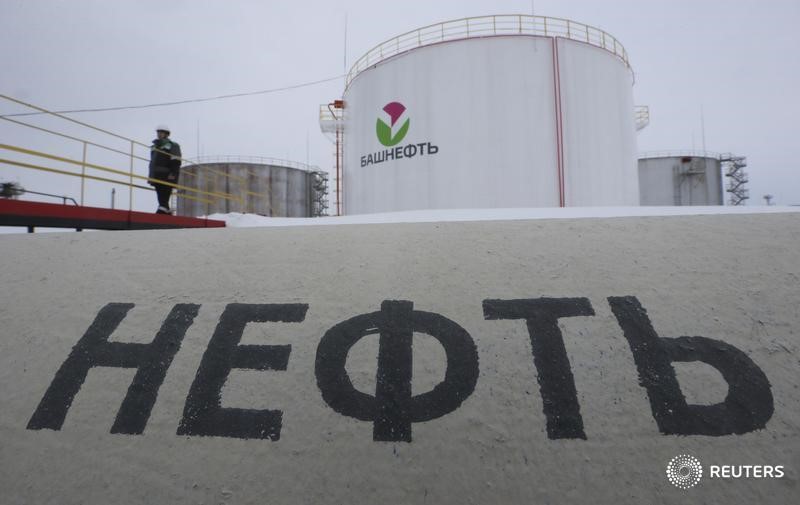Commodities
Oil ends with 1st weekly loss in 4; Russia fuel exports ban limits downside


© Reuters.
Investing.com — Crude prices had first weekly loss in four after the Federal Reserve signaled it might raise interest rates again before the end of the year — and anytime inflation gets out of hand.
The downside in oil prices was, however, limited by Russia’s export ban on fuels, which counteracted fears that slowing economies and high interest rates could crimp demand for energy.
New York-traded West Texas Intermediate, or , crude for delivery in November settled at $90.03 per barrel, 40 cents, or 0.5%, on the day. WTI earlier hit an intraday high of $91.31, after Tuesday’s 10-month high of $93.74. For the week, the U.S. crude benchmark was down 0.6%, after a cumulative gain of almost 14% over three weeks.
London-traded settled at $93.27 a barrel up, down 3 cents, or 0.03%. Brent rose to as high as $94.64 earlier on the day, after Tuesday’s 10-month high of $95.96. The global oil benchmark was down 0.7% on the week, after a cumulative gain of nearly 11% over three weeks.
The dollar strengthened after the Fed projected another quarter-percentage point by the year-end, despite leaving rates unchanged for September itself at a policy meeting on Wednesday.
“We are prepared to raise rates further, if appropriate,” Fed Chairman Jerome Powell told a news conference. “The fact that we decided to maintain the policy rate at this meeting doesn’t mean we have decided that we have or have not at this time reached that stance of monetary policy that we are seeking.”
Energy-driven inflation one of the Fed’s concerns
Powell said energy-driven inflation, led by the 30% rally in oil prices since June, was one of the Fed’s bigger concerns.
The Fed had raised interest rates 11 times between February 2022 and July 2023, adding a total of 5.25 percentage points to a prior base rate of just 0.25%.
Economists fear that the Fed’s renewed hawkish stance will dampen global growth though many also agree that a lid has to be put on oil prices if the Fed is to achieve its annual inflation target of 2%.
Russia said on Friday it has implemented an immediate ‘temporary’ suspension of gasoline and diesel exports to all countries except for four former Soviet states and its own overseas military bases, with the goal of stabilizing its domestic market.
Kremlin fuel export ban will further tighten oil market
Russia’s Transneft then suspended deliveries of diesel to the key Baltic and Black Sea (NYSE:) terminals of Primorsk and Novorossiysk on Friday, state media agency Tass said.
The Kremlin said the ban was “temporary” and designed to address rising energy prices in Russia. Russian wholesale gasoline prices were down nearly 10% and diesel down 7.5% on Friday after the ban.
The ban will “bring new uncertainty into an already tight global refined product supply picture and the prospect that the impacted countries will be seeking to bid up cargoes from alternative suppliers,” RBC said in a note.
Diesel is the workhorse fuel of the global economy, playing a crucial role in freight, shipping and aviation. Derivatives of diesel such as are particularly susceptible to winter price surges. Germany and the north-east of the U.S. are both heavily reliant on the fuel for heating homes.
Russia is the world’s second-largest seaborne exporter of diesel after the U.S., according to Kpler, a freight data analytics company, and before its invasion of Ukraine was the single biggest diesel exporter to the EU. The EU and U.S. have largely banned imports of Russian refined fuel since February, forcing Moscow to reroute its sales to Turkey and countries in North Africa and Latin America.
Russian refined fuel sales, particularly diesel, remain a critical part of oil supplies. In August Russia exported more than 30mn barrels of diesel and gas-oil — a diesel proxy — by sea, according to oil cargo tracker Kpler.
(Peter Nurse and Ambar Warrick contributed to this item)
Commodities
Oil prices rise; U.S. crude inventories plunge, Russia-Ukraine truce eyed
Commodities
India’s Reliance to stop buying Venezuelan oil over US tariffs, sources say
Commodities
Oil prices climb on Venezuela supply worries

 Forex3 years ago
Forex3 years agoForex Today: the dollar is gaining strength amid gloomy sentiment at the start of the Fed’s week

 Forex3 years ago
Forex3 years agoUnbiased review of Pocket Option broker

 Forex3 years ago
Forex3 years agoDollar to pound sterling exchange rate today: Pound plummeted to its lowest since 1985

 Forex3 years ago
Forex3 years agoHow is the Australian dollar doing today?

 Cryptocurrency3 years ago
Cryptocurrency3 years agoWhat happened in the crypto market – current events today

 World3 years ago
World3 years agoWhy are modern video games an art form?

 Commodities3 years ago
Commodities3 years agoCopper continues to fall in price on expectations of lower demand in China

 Economy3 years ago
Economy3 years agoCrude oil tankers double in price due to EU anti-Russian sanctions























